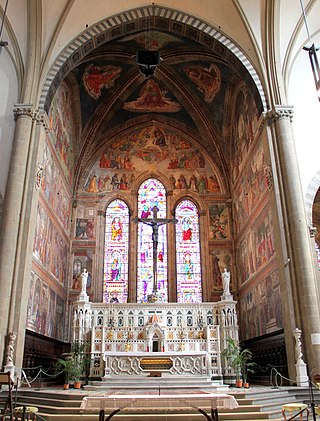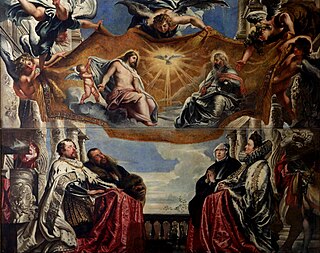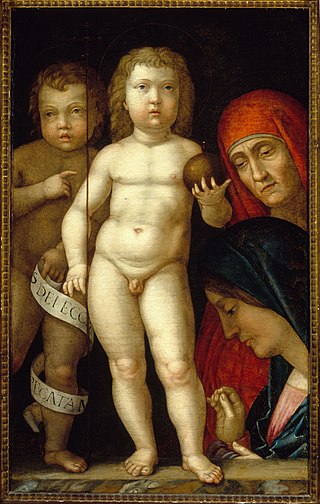
Andrea Mantegna was an Italian painter, a student of Roman archeology, and son-in-law of Jacopo Bellini.

The Basilica of Saint Francis of Assisi is the mother church of the Roman Catholic Order of Friars Minor Conventual in Assisi, a town in the Umbria region in central Italy, where Saint Francis was born and died. It is a papal minor basilica and one of the most important places of Christian pilgrimage in Italy. With its accompanying friary, Sacro Convento, the basilica is a distinctive landmark to those approaching Assisi. It has been a UNESCO World Heritage Site since 2000.

The Baptism of Christ is an oil-on-panel painting finished around 1475 in the studio of the Italian Renaissance painter Andrea del Verrocchio and generally ascribed to him and his pupil Leonardo da Vinci. Some art historians discern the hands of other members of Verrocchio's workshop in the painting as well.

The Doni Tondo or Doni Madonna is the only finished panel painting by the mature Michelangelo to survive. Now in the Uffizi in Florence, Italy, and still in its original frame, the Doni Tondo was probably commissioned by Agnolo Doni to commemorate his marriage to Maddalena Strozzi, the daughter of a powerful Tuscan family. The painting is in the form of a tondo, meaning in Italian 'round', a shape which is frequently associated during the Renaissance with domestic ideas.

This article about the development of themes in Italian Renaissance painting is an extension to the article Italian Renaissance painting, for which it provides additional pictures with commentary. The works encompassed are from Giotto in the early 14th century to Michelangelo's Last Judgement of the 1530s.

San Francesco della Vigna is a Roman Catholic church in the Sestiere of Castello in Venice, northern Italy.

The Tornabuoni Chapel is the main chapel in the church of Santa Maria Novella, Florence, Italy. It is famous for the extensive and well-preserved fresco cycle on its walls, one of the most complete in the city, which was created by Domenico Ghirlandaio and his workshop between 1485 and 1490.

The Gonzaga Family in Adoration of the Holy Trinity is a painting by the Flemish artist Peter Paul Rubens, housed in the Ducal Palace in Mantua, Italy. The work was commissioned by Duke Vincenzo I Gonzaga for the Jesuit church in Mantua, while Rubens was his court painter.

The Baptism of Christ is a fresco by the Italian Renaissance painter Pietro Perugino and his workshop, executed around 1482 and located in the Sistine Chapel, Rome.

The Montemirabile or Saint John the Baptist Chapel, otherwise the Baptistery is the first side chapel in the left aisle in the Basilica of Santa Maria del Popolo.

Holy Family with Saints Elizabeth and John the Baptist is a fragment of fresco from the Basilica of Sant'Andrea, Mantua, now held in Mantua's Diocesan Museum. It was painted ca. 1509–1511 by the Italian Renaissance painter Correggio and is 1.5m in diameter. It shows the Virgin Mary, the Christ Child, St Joseph (right), St Elizabeth (left) and the infant John the Baptist.

The Mantegna funerary chapel is one of the chapels of the Basilica of Sant'Andrea, Mantua. It houses the tomb of the painter Mantegna and his last two paintings – Baptism of Christ and Holy Family with St John the Baptist, St Elizabeth and St Zacharias (1504–1506). Its frescoes from 1507 were painted by his sons Ludovico and Francesco and by a young Correggio. The tomb bears a bronze figure of Mantegna by Gianmarco Cavalli.

The Madonna of the Caves is a tempera on panel painting measuring 32 cm 29.6 cm. It was painted in 1488-1490 by the Italian painter Andrea Mantegna and is now in the Uffizi Gallery in Florence.

The Holy Family with the Infant Saint John the Baptist is a tempera on canvas painting measuring 71 cm by 50.5 cm. It is attributed to Andrea Mantegna, dated to around 1500 and now held in the National Gallery, London. Due to its poor conservation, the autograph is unclear, so some scholars do not directly attribute it to Mantegna. Though, those that do argue its idea and format definitely refer to autographed works by him.

The Holy Family with Christ as Imperator mundi is a 71 by 50.5 cm tempera on canvas painting dated to around 1490-1500. It is attributed to Andrea Mantegna and now held in the Petit Palais in Paris.

The Holy Family and the Family of Saint John the Baptist is a casein tempera on canvas painting with gilding, measuring 40 by 169 cm and dating to around 1504-1506. It was painted by Andrea Mantegna and was mentioned by his second son Francesco as still being in Andrea's studio on his death in 1506. According to Andrea's wishes, both it and Baptism of Christ were assigned to his funerary chapel in the Basilica of Sant'Andrea, Mantua, where they still hang. The choice of theme is linked to the chapel's dedication to John the Baptist.

The Pesaro Altarpiece is an oil-on-panel painting by the Italian artist Giovanni Bellini, dated to some time between 1471 and 1483. It is considered one of Bellini's first mature works, though there are doubts on its dating and on who commissioned it. The work's technique is not only an early use of oils but also of blue smalt, a by-product of the glass industry. It had already been used in the Low Countries in Bouts' 1455 The Entombment, but this marked smalt's first use in Italian art, twenty years before Leonardo da Vinci used it in Ludovico il Moro's apartments in Milan in 1492. Bellini also uses the more traditional lapis lazuli and azurite for other blues in the work.

The Transfigured Christ is a 1513 oil-on-panel painting by Andrea Previtali, in the Pinacoteca di Brera in Milan since 1811 It is signed and dated Al Nobel homo mr/Andrea dipintor in/Bergamo/MDXIII on a small book at bottom right.

The Suardi Chapel is an oratory or private chapel inside the villa in Trescore Balneario, Province of Bergamo owned by the Suardi counts. It is dedicated to Saint Barbara and Saint Brigid and was completely rebuilt by the cousins Giovan Battista and Maffeo Suardi. It was fully covered in 1524 by frescoes commissioned by them from Lorenzo Lotto of Christ the Vine and Lives of the Saints. In the 19th century, count Gianforte Suardi built a corridor connecting the chapel to the villa and modified the chapel entrance – those entering had previously immediately found themselves in front of the north wall with its depiction of Christ the Vine.

Descent into Limbo or Descent into Hell is an oil-on-panel painting executed c. 1530–1535 by the Italian Renaissance painter Domenico Beccafumi, now in the Sienese Grand Masters room in the Pinacoteca Nazionale in Siena. With the Saint Martin Nativity and Holy Family with the Infant John the Baptist it is one of the last works commissioned from the artist by the Beccafumi Marsili family for their family chapel at the Basilica of San Francesco in Siena. Damaged by a fire in 1655, the painting was seen by Giorgio Vasari, who praised it for the uniqueness of its figures, prefiguring Mannerism.




















